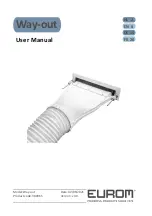
–45–
TH9
Four-way valve
Compressor
Accumulator
CS circuit
Separ
ate compressor
TH2
LPS
Heat exchanger
Outdoor heat e
xchanger
Indoor heat
e
xchanger
Flo
w control
valv
e
Operation mode
Full cooling
Cooling mainly
Full heating
Heating mainly
Defrosting
ON
ON
OFF
OFF
OFF
OFF
ON
ON
OFF
OFF
OFF
OFF
OFF
ON
ON
ON
ON
OFF
ON
ON
ON
ON
ON
OFF
OFF
ON
ON
ON
ON
OFF
OFF
OFF
ON
ON
ON
ON
OFF
ON
ON
ON
ON
OFF
ON
OFF
ON
ON
ON
OFF
ON
OFF
OFF
ON
ON
ON
ON
OFF
ON
OFF
OFF
OFF
OFF
OFF
OFF
OFF
OFF
OFF
OFF
OFF
OFF
ON
OFF
OFF
OFF
ON
ON
OFF
ON
OFF
OFF
OFF
OFF
OFF
ON
OFF
OFF
OFF
OFF
OFF
OFF
ON
ON
OFF
OFF
OFF
ON
ON
OFF
OFF
OFF
OFF
OFF
ON
OFF
OFF
OFF
OFF
OFF
OFF
ON
ON
OFF
OFF
OFF
ON
Operation pattern
SV3
SV4
SV5
SV6
SV7
SV8
Solenoid valve
* In stop, all are OFF.
(9)
Outdoor unit heat exchanger capacity control
1) Control method
•
In order to stabilize the evaporation temperature during cooling and the high-pressure pressure during heating that
are required in response to performance needs, the capacity of the outdoor heat exchanger is controlled by regulat-
ing the fan volume of the outdoor unit by phase control and controlling the number of fans and by using the solenoid
valves to vary the number of out door heat exchangers being used.
2) Control
•
When both of the compressors are stopped, the fans for the outdoor units are also stopped.
•
The fans operate at full speed for 5 seconds after starting.
•
The fans for the outdoor unit are stopped during defrosting.
3) Capacity control pattern
(10) Circulating composition sensor (CS circuit)
• As shown in the drawing below; the CS circuit has the structure to bypass part of the gas discharged from the compres-
sor through the capillary tube to the suction side of the compressor, exchange heat before and after the capillary tube,
and produce two phase (gaseous and liquid) refrigerant at the capillary tube outlet. The dryness fraction of refrigerant at
the capillary tube outlet is estimated from the temperature of high pressure liquid refrigerant at the capillary tube inlet
(TH9) and the temperature of low pressure two phase (gaseous and liquid) refrigerant at the capillary outlet (TH2) and
the pressure (LPS) to calculate the composition of refrigerant circulating the refrigeration cycle (
α
OC). It is found by
utilizing the characteristic that the temperature of two phase (gaseous and liquid) R407C under a specified pressure
changes according to the composition and dryness fraction (gas-liquid ratio in weight).
• The condensing temperature (Tc) and the evaporating temperature (Te) are calculated from
α
OC, high pressure
(HPS), and low pressure (LPS).
• The compressor frequency, the outdoor fan, and others are controlled according to the codensing temperature (Tc)
and the evaporating temperature (Te).
• CS circuit configuration (Outline drawing)
Содержание City Multi P500YEM-A
Страница 14: ...13 CNFAN CNPOW CNFC2 CN15V1 CNDR1 CNIPM1 CNE CNDC1 FANCON board G A board...
Страница 15: ...14 Y C board SNB board...
Страница 16: ...15 BC controller CNTR CN02 M NET transmission CN03 CN12 Power supply 1 EARTH 3 N 5 L SW4 SW2 SW1 SW5...
Страница 17: ...16 RELAY 10 board RELAY 4 board...
Страница 70: ...69 1 3 2 4 CV5b CV7b SV7 SV8 Solenoid Valves Block 2 CV4b CV6b CV2b ST1 BV1 BV2 CV3b 1 2 3 4...
Страница 72: ...71 Check Valves Block2 1 3 5 7 6 4 2 CV5b CV4b CV6b CV2b ST1 BV1 BV2 CV3b Check Valves Block2 1 3 7 2 4 5 6...
















































